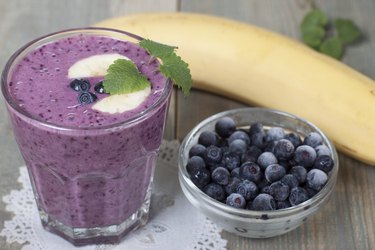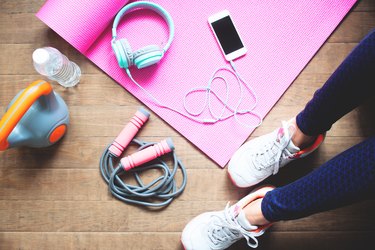
There's no shortcut to shrink your belly in a week, but you can set the foundation for belly fat loss in that time. While you may see minor differences quickly, it's even more important that the changes you make will set you on a road to long-term success — without the high risk of weight regain associated with fad crash diets.
Here, you'll find out why lifestyle changes are the way to go and get a 7-day kickstart plan to help you blast belly fat.
Video of the Day
Video of the Day
Set Realistic Goals
First things first: Understand that you won't (and shouldn't) shed a huge chunk of weight fast or lose fat exclusively from your belly — it will come from all over your body slowly, as well as your midsection, according to Yale Scientific Magazine. You can, however, lose 1 to 2 pounds of fat to start slimming your midsection in the first week, per the Mayo Clinic. Using sustainable methods will allow for larger weight loss over longer periods of time.
To start torching body fat, you'll need to eat fewer calories than you burn daily — about 500 to 1,000 calories fewer — in order to lose those 1 to 2 pounds per week. That calorie deficit allows you to burn fat, but it won't generally trigger "starvation mode" that would lead to muscle loss over time.
Not sure where to go from here? Take a look at this 7-day kickstart plan — during each day, you'll add a new healthy habit, and by the end of the week, you'll have established a roster of practices that will help you lose belly fat over time.
Day 1: Add Fiber With Plants
Start by adding fruits and vegetables to your meals and snacks. "Fiber-rich fruits and veggies are great to incorporate for fat loss because they have a higher satiety factor, keeping you full for longer," says Jim White RDN, an ACSM-certified exercise physiologist.
Other fiber benefits include easing constipation, lowering cholesterol and helping maintain blood sugar levels, per the Mayo Clinic. Plus, eating fiber-rich foods helps "keep us full on foods that have plenty of vitamins and minerals, so we may be less likely to grab for empty-calorie snacks," White says.
Try incorporating one new vegetable side at lunch or dinner, and add one fruit in at breakfast time, White suggests.
How to Add More Fiber to Your Diet
- Snack on prunes, carrots and hummus, apple slices or a clementine
- Throw spinach, peppers and mushrooms into an omelette to beef up the nutrient density
- Keep frozen berries and bananas on hand to add into protein shakes
- Bake sweet potato slices as a side for dinner
- Top your sandwich with avocado, tomato and dark green leafy vegetables
Day 2: HIIT It Up

Stuck in a cardio rut? Hate working out or can't find the time to commit to a full workout regimen? Get in a HIIT workout a couple of times a week and you'll start to see a difference in your body. For people with obesity, HIIT led to significant positive changes, including cardiometabolic health, according to an October 2016 study in British Journal of Sports Medicine.
"If you're looking to burn belly fat, HIIT is the best addition to your plan. In combination with proper nutrition and determination, it is absolutely game changing," per Logan Shaw, ISSA Elite-certified personal trainer. "When you perform HIIT workouts, you push your cardiovascular and metabolic systems to their maximum potential," Shaw says. You'll burn more fat and calories than during a steady paced workout, and the effect will last for several hours after the activity has ended, he notes.
Even short-term HIIT workouts can lead to a fair amount of body composition improvements without losing weight, despite minimal time commitment, per a June 2017 article in Obesity Reviews.
"HIIT workouts are approximately 20 to 30 minutes long. Typically, there will be sets of 30 to 45 seconds of intense workouts, followed by 15 to 30 seconds of rest. When performing in these sets we are exercising our heart," Shaw says. "Your heart rate reaches 70 to 90 percent of its max rate during a set, and 60 to 65 percent of our max heart rate at rest. This turns your entire body into a calorie and fat burning machine."
Try One of These HIIT Workouts
Day 3: Get to Bed Earlier

These days, getting enough shut-eye is tough with busy work and life schedules. But if you hit the sack earlier, you could be helping with the battle of the bulge.
Sleep deprivation is found to increase belly fat accumulation, according to the National Sleep Foundation. Researchers found that people sleeping less than 5 hours at night gained more belly fat over several years. Sleep deficits are linked to increased food intake, decreased energy expenditure and changes in appetite-regulating hormones levels, according to an August 2014 review in Annals of Medicine.
Get Better Shut-Eye
Day 4: Put Down That Wine Glass
A glass of wine or cocktail here and there is perfectly fine, but keep that drink to one serving.
"Alcohol contributes to weight gain because it has a high energy density (providing 7 kcals per gram) but does not provide a good source of nutrients to our body to use as fuel," White says. Since it's common to drink while socializing, it's easy to load up on calories without realizing, he says. "Alcohol can compromise decision-making or stimulate hunger, so you may be more likely to consume food while drinking even though your body isn't in need of the extra calories," White notes.
Opt for These Beverages
Day 5: Make Room for Whole Grains
There's no time like the present to swap refined carbs for nutritious whole grains. Refined carbs like white bread, pasta and rice as well as chips and sweets, according to Harvard Health Publishing, cause sharp spikes in blood sugar and raise triglyceride levels, which will lead to a belly bulge. Whole grains maintain blood sugar and have tons of fiber, phytochemicals and essential minerals.
Recent studies show that eating whole grains helps people maintain healthier weights, as reported by Nutrients in a May 2019 article. So, go ahead — enjoy whole grain cereals, pasta and bread, oatmeal, brown rice and quinoa.
Here's How to Prepare Whole Grains
Day 6: Handle Your Stress

Definitely easier said than done, but chill out! Stressing out is a belly fat culprit as studies have shown the close association of increased cortisol levels and deep abdominal fat deposits, per the American Institute of Stress.
"Stress and its release of cortisol has us turning to bad choice foods (for comfort)," Shaw says.
Stress-Busting Habits
- Get moving. Instead of reaching for snacks, try going for a walk (at any pace), Shaw suggests.
- Try meditating. Picking up the practice "drastically helps us mentally, physically and emotionally," Shaw says.
Day 7: Don’t Fear Fats
Many people try to eliminate fat entirely when trying to lose weight, but your body needs the healthy fats found in certain veggies, oils, nuts, seeds and fish.
"Mono- and polyunsaturated fats have a chemical structure and function much different than saturated fats that allows them to act differently in the body," White says. Eating foods with omega-3 fatty acids — a type of polyunsaturated fats — is beneficial to your heart health, per Harvard T.H. Chan School of Public Health. "These healthy fats include avocados, walnuts, salmon and chia seeds. It's important to note that weight loss is a result of many different factors, so these foods are not quick fixes for fat loss," White says.
Sub in Healthy Fats
Here are some suggestions for easy fats swaps from White:
- Switch to olive or avocado oil, in place of butter or coconut or palm oil
- Have fish in place of red meat for dinner tonight (try Salmon and Brocolette Superfood Salad or Grilled Tilapia Tacos With Red Cabbage Slaw)
- Opt for a handful of nuts or smashed avocado on whole grain toast in place of packaged snacks
An Extra Boost
It's OK if you feel a little overwhelmed as you go through this 7-day kickstart plan. If you think you need some support or a more guided plan, talk to a dietician, nutritionist or personal trainer. Other than that, stay committed, know that it's OK to mess up and that it's all about progress, no matter how slow it's going.
- Yale Scientific Magazine: "Targeted Fat Loss: Myth or Reality?"
- Mayo Clinic: "Counting Calories: Get Back to Weight-Loss Basics"
- British Journal of Sports Medicine: " Effects of High-Intensity Interval Training on Cardiometabolic Health: A Systematic Review and Meta-Analysis of Intervention Studies"
- Obesity Reviews: "The Effects of High-Intensity Interval Training vs. Moderate-Intensity Continuous Training on Body Composition in Overweight and Obese Adults: A Systematic Review and Meta-Analysis"
- National Sleep Foundation: "Sleep Linked to Abdominal Fat"
- Annals of Medicine: "Sleep Debt and Obesity"
- Harvard Health Publishing: "Healthy Eating for Blood Sugar Control"
- Nutrients: "The Relationship between Whole Grain Intake and Body Weight: Results of Meta-Analyses of Observational Studies and Randomized Controlled Trials"
- Public Health Nutrition: "Whole-grain Intake as a Marker of Healthy Body Weight and Adiposity"
- The American Institute of Stress: "Stress, Cortisol and Abdominal Fat"
- Mayo Clinic: "Dietary fiber: Essential for a healthy diet"
- Harvard T.H. Chan School of Public Health: "Omega-3 Fatty Acids: An Essential Contribution"
- Harvard T.H. Chan School of Public Health: "Whole Grains"
- Mayo Clinic: "Nutrition and Health Eating"